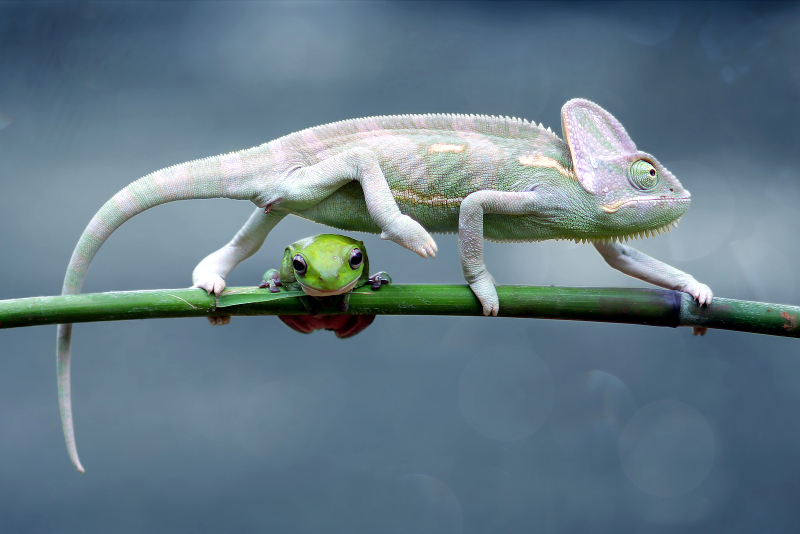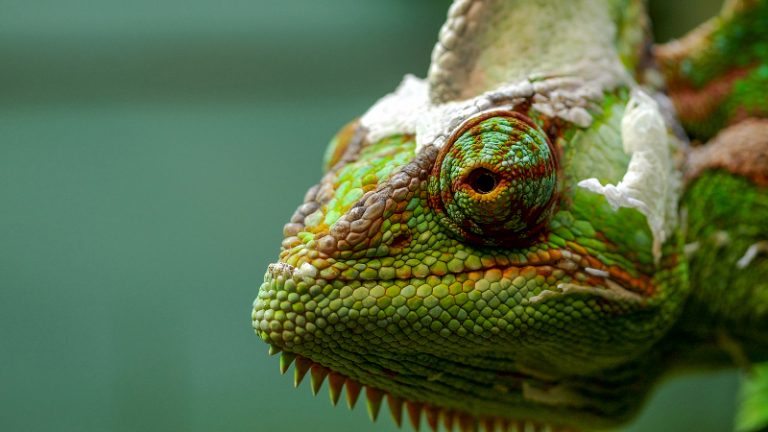How Long Do Veiled Chameleons Live (& How To Extend It)

If you’re thinking about getting a Veiled Chameleon as a pet, then let’s talk about their average lifespan. Unfortunately, most Veiled Chameleons in captivity don’t survive past two years due to inept care. In this article, we’ll begin with a brief overview of the Veiled Chameleon. Then, we’ll discuss how long they live in captivity and the wild.

Finally, we’ll explain what influences their lifespan and how you can elongate it if you have a Veiled Chameleon as a pet.
Contents
Table of Contents
What Is A Veiled Chameleon?
Veiled Chameleons are one of 160 species of Chameleons. They are commonly found on coastal plains, mountains, and high deserts in Yemen and Saudi Arabia.
This Chameleon got its name because of the veil on top of its head, which helps them survive the harsh hot weather of these climates. In addition to staying cool, dew drops can collect on the veil and trickle down to the mouth and hydrate them.
Even though Chameleons are relatively small, this particular one is one of the largest Chameleons. For instance, they can grow about 18 to 20 inches long, depending on their gender. Sometimes, males can grow up to 24 inches long.
Also, this Chameleon has a varied diet from insects to dark leafy greens. They might even enjoy vegetables and fruit once in a while.
Overall, Veiled Chameleons are calm and quiet. They’ll make excellent pets, but they prefer to be alone. They’ll become stressed and possibly aggressive if they’re handled too much.
How Long Does A Veiled Chameleon Live In The Wild?
Many different factors will affect the lifespan of a Veiled Chameleon in the wild. Their lifespan can be shorter or longer, depending on their gender. For example, a female Veiled Chameleon in the wild has an average lifespan of about two to four years. On the other hand, a male Veiled Chameleon will have an average lifespan of about three to five years in the wild.
How Long Do Veiled Chameleons Live In Captivity?
In captivity, Veiled Chameleons have a longer lifespan. This is because they’re getting proper, consistent care. A Veiled Chameleon doesn’t need to worry about predators or varying weather conditions as a pet.
So, a female Veiled Chameleon in captivity has an average lifespan of up to five years. On the other hand, a pet male Veiled Chameleon can have an average lifespan of up to eight years.
Watch this video: How Long Do Veiled Chameleons Live
What Can Influence How Long Veiled Chameleons Live?
As mentioned earlier, many factors can influence the length of your Veiled Chameleon’s lifespan. Let’s talk about a few of them.
Gender
First, their gender can affect their lifespan. Female Veiled Chameleon lives shorter than males, whether they’re in captivity or the wild.
This is because females produce eggs and carry the babies. So, this takes up much of their energy and ages them faster. Thus, they have a shorter lifespan.
However, a female in captivity may have a slightly longer lifespan than normal if they do not have hatchlings. There have been female Veiled Chameleons living for up to eight years as pets. So, it’s not impossible.
Care
The type of care a Veiled Chameleon receives also affects its lifespan.
For example, in the wild, Veiled Chameleons need to worry about their environment. While they have plenty of places to hide, climb, and roam, there are predators about.
Also, the weather is unpredictable. For instance, if there’s a drought, they won’t be able to get the hydration they need, thus getting sick.
In addition, they might have an inconsistent diet. Veiled Chameleons won’t travel far so if they can’t find insects for a day, then they won’t eat.
On the other hand, Veiled Chameleons need proper care in captivity. For example, they need consistent dieting and hydration plus proper housing.
So, let’s discuss a few ways that you can help your Veiled Chameleon live as long as they can.
Tips To Help Your Veiled Chameleon Live As Long As Possible
Unfortunately, Veiled Chameleons aren’t all that easy to care for. They have certain needs that need to be just right, or they can become stressed or sick. So here are some tips to give the best care possible to your Veiled Chameleon to help them thrive.
Proper Housing
Veiled Chameleons are arboreal, which means they’re often found climbing trees and plants. So, they’d love to have an enclosure that allows them to climb high.
A cage that’s at least 40 inches tall is ideal. However, the best size to get is at least 24x24x48 inches. Then you can add branches, vines, and other plants to allow your Veiled Chameleon to climb to the top of their enclosure.
In addition, they need a cage that’s screen-sided all the way around for proper ventilation. Do not get a plastic or glass tank because they won’t get the air they need, thus getting stressed and sick.
They also need humidity and misting to stay hydrated a few times per day. The temperature in their enclosure should be about 72 to 85 degrees F during the day and no less than 60 degrees F at night. Also, give them a basking spot of at least 95 degrees F for about 12 hours a day.
Dieting
In addition, you’ll need to feed your Veiled Chameleon a consistent diet. The diet will be dictated by the Veiled Chameleon age. As hatchlings, they’ll eat a lot of crickets and other insects per day. As they grow older into juveniles and adults, they’ll eat less.
However, they still need plenty of protein, calcium, and vitamin D to grow and develop well.
Feeding should be at the same time every day so that your Veiled Chameleon will know when they’ll get their food. Also, be sure to give them enough time in between feeding to bask so they can fully digest their previous meal.
Finally, only put enough food in their enclosure to consume within five minutes, per feeding.
Learn more about a Veiled Chameleon’s diet here.
Diseases
Veiled Chameleons are pretty hardy since they’re reptiles. However, that doesn’t mean they can’t get sick, and you shouldn’t take them to the vet.
You should bring your Veiled Chameleon to the vet at least once a year for their annual checkup as you would for your dog or cat.
Veiled Chameleons can become stressed, thus getting sick, if they don’t have the correct housing, diet, or care.
For example, keep an eye out for the following symptoms or behavior:
- Lack of movement
- Lack of appetite
- Injury
- Darker colors on their skin (could be a sign of stress)
- Foaming at the mouth
- Dark-colored urine
- Film over eyes
- A bulge on their body
- Loose skin
If you believe your Veiled Chameleon is sick or acting off, then call your vet. It’s better to be safe than sorry.
Conclusion
Overall, Veiled Chameleons can be around as a pet for a long time. However, you need to ensure that you’re providing them with the best care possible.
Also, keep a watch out for signs of being stressed, scared, or sick. Then, you’ll be able to have your reptile friend for a while.
Learn more about Chameleons here. You can also click here to read our guide to how long other types of Chameleons live or here to find out how big Veiled Chameleons grow.



![What Do Veiled Chameleons Eat? [Full Guide]](https://allourcreatures.com/wp-content/uploads/2021/12/veiled-chameleon-eating-768x512.jpg)

![How Fast Do Chameleons Grow? [Must Read]](https://allourcreatures.com/wp-content/uploads/2021/12/Pygmy-Chameleon-001-768x513.jpg)
